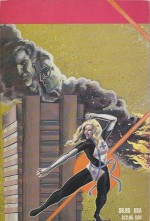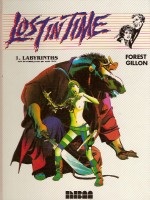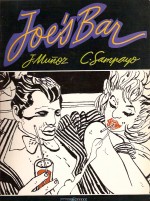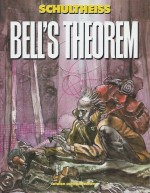

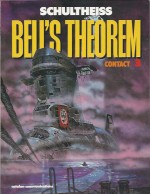
By Matthias Schultheiss, translated by Tom Leighton & Bernd Metz (Catalan Communications)
ISBNs: 0-87416-037-5, 0-87416-062-6 and 0-87416-074-X
Although German, supreme sequential stylist Matthias Schultheiss, like so many other international comics creators, found widespread fame and success in France’s monumental bandes dessinées publishing culture.
Born in Nuremberg in 1946 the award-winning author and artist began his working life as an apprentice cabinet maker, before studying illustration at Hamburg’s Academy of Fine Arts. After graduation he freelanced in the commercial art field until 1981 when his graphic novel The Trucker began in the magazine Comics umgesetzt (the Comic Reader). After illustrating Charles Bukowski’s The Long Job, and Broken in the City, after which, in 1984, the artist self-penned the controversial Kalter Krieg (Cold War), which was “forbidden†by West Germany’s Federal Review Board and listed as a “harmful publication†due to perceived problems with its despondent political tone.
With The Trucker syndicating in Denmark, Schultheiss met with French publisher Albin Michel in 1985, producing shorts for the prestigious L’Écho des savanes. That same year he began the groundbreaking metaphysical thriller and philosophical tour de force Die Wahrheit über Shelby (The Truth about Shelby) under discussion here.
Three spectacular, challenging and uncompromising volumes Lebenslänglich, Die Verbindung and Der Kontakt (Lifetime, The Compound and The Contact) appeared between 1996-1988, to great international acclaim, and since then Schultheiss has produced a number of challenging, epic works for increasingly broader markets, including the triptych The Sharks of Lagos, The Track, Night Taxi, Talk Dirty amongst others.
In 1993 he produced the strikingly surreal superhero Propeller Man for Dark Horse Comics – to decidedly mixed American reception – after which he more or less abandoned comics for television writing, only returning in 2002 with The Puddle.
Since then he has produced Woman on the River for manga giant Kodansha, Travels with Bill, and Daddy, a controversial and pithy exploration of the Second Coming of Jesus…
Translated and released by Catalan Communications in the late 1980s, The Truth about Shelby became Bell’s Theorem and the three volumes were redubbed Lifer, The Connection and Contact, introducing a vicious, hard-as-nails career thug rechristened “Shalby†and following his inevitable path to destruction after he’s picked out by an incomprehensible universe to endure the cosmic vagaries of quantum mechanics in irresistible motion…
Just in case you were wondering: the new title comes from John Stewart Bell’s 1964 paper “On the Einstein Podolsky Rosen paradoxâ€, in which the renowned Irish physicist addressed the objections cited by science giants Albert Einstein, Boris Podolsky and Nathan Rosen who didn’t fully accept the plausibility of a Theory of Quantum Mechanics.
Summed up in the statement “No physical theory of local hidden variables can ever reproduce all of the predictions of Quantum Mechanicsâ€, Bell introduced the concept of Hidden Variable Theories to show how the old guard’s stipulations that the effects of Locality and Realism negated the possibility of quantum physics.
I’m sure I’ve got that all wrong, but suffice to say for the sake of the comic tale here, it means that all events are connected in ways we can’t necessarily perceive or understand…
Lifer introduces Shalby, a vicious criminal not long for this world. The other convicts are determined to kill him, but after the latest savage attack the callous thug finally accedes to the warden’s insistent offers and signs up for an experimental program in another jail. He doesn’t even care that much if the promised pardon for surviving the tests is real or not…
Deep in a desert complex under burning skies, Shalby is injected with drugs and strapped to a ghastly hi-tech torture chair. The first session reduces him to a bloody, leaking wreck and whilst recovering in the infirmary he is visited by another test-subject, sneaking in through an air-duct…
Even with half his face missing Frank seems to know what’s going on. The place is part of a top secret military project and the other prisoners have no chance of survival, but if Shalby can escape before he becomes too weak he can blow the whistle on the whole sordid mess…
With Frank’s aid Shalby kills one of doctors and makes his break; hopping a freight train and hitching rides to anywhere else. However the drugs in his system are still working: he’s feeling shaky and can’t stop bleeding. Luckily Frank gave him some pills and hypos to counteract the effects of the scientists’ experiments…
With cops hard on his tail, Shalby collapses and is rescued by a young doctor who hides him and tends to his many wounds. After two weeks the fugitive is fighting fit again and his saviour has also provided him with a car and money. Immune to gratitude, Shalby rapes her when she refuses to sleep with him before heading off into the night…
Determined to escape at all costs, Shalby heads north and buys passage to Canada on a smuggling plane, landing on a desolate stretch of seashore in Labrador, miles from anywhere…
The beach is strewn with maritime wrecks, debris and the skeletons of whales. Constantly far out to sea, Shalby’s only companions are more of the vast cetaceans, sporting in the cold uninviting waves.
However, his search for shelter only offers mystery as the brute discovers bizarre machines everywhere: peculiar contraptions of string and bone, sticks and scraps of metal…
When he falls into a pit he finds a mummified corpse wearing more of the impossible devices and headphones made from discarded tin-cans. The place is a bunker of sorts with science texts and esoteric notes scattered everywhere, but beggars can’t be choosers and Shalby repairs the roof and moves in.
The notes belong to Mark Amselstein, a physicist from Hamburg, who also left cash and a passport. The photo shows that Amselstein was a dead ringer for Shalby and his jottings describe an incredible experiment into insane connections in time and space. Moreover, whenever the whales appear, those tin headphones crackle with eerie, haunting sounds…
In all this time alone, Shalby has been unaware that there are hunters on his trail, but when he spots a plane circling above his beach the fugitive acts instantly, snatching up Amselstein’s papers, passport and whatever else he can carry, setting off inland just as winter hits the great wilderness.
Weeks later a weary, shaggy trapper walks into snowbound Montreal, rents a hotel room and emerges as Mark Amselstein, Ph. D. Buying as ticket to Hamburg and idly attempting to pick up a woman in the airport bar, the dapper doctor is abruptly accosted by two mysterious men…
Shalby, with the aid of an unsuspecting innocent bystander, savagely deals with the enigmatic agents and hurriedly boards his flight, but soon realises that he is experiencing horrifying, unimaginable hallucinations…
The Connection opens with Shalby recoiling from a dusty decaying spectre in a parka and goggles, who quickly resolves into a pretty fellow passenger. Shaken, he subsides into pensive speculation and when the plane lands quickly debarks and heads for Amselstein’s old address. Meanwhile in a sanatorium, the normally quiescent Paul begins to strain against his straitjacket. The attendants don’t understand why he keeps screaming “he’s hereâ€â€¦
Amselstein’s apartment is an empty hovel by the docks, deep in the infamous Red Light district of the Reeperbahn. However a clever clue leads the escaped convict to the missing physicist’s true base, an abandoned dredger deep in the ice-bound industrial wasteland of the Harbour.
His arrival has not gone unnoticed. One streetwalker in particular is keen to observe him, as are a number of furtive men haunting the area but utterly uninterested in the flesh on sale and for rent…
As Shalby investigates the old scow he finds more of the esoteric scrap-and-string constructions amidst the shambolic cabins but no immediate threat and, exhausted, dozes off.
Elsewhere his dogged followers are revealed as American spies, desperate to recover the missing scientist who was a vital part of their Star Wars Defence Initiative. At the highest level the decision is made: get Amselstein back, willing or otherwise…
Further exploring the deserted hulk, Shalby finds fresh food and more of the dead boffin’s notes. Baffled by concepts which impossibly stipulate that the universe is constantly created by the beings in it and that all times and places are one, the bewildered thug experiences all-consuming, full-sensory flashbacks and finds himself returned to the beach, playing underwater with cetaceans and on the dredger’s bridge all at once.
As the Americans search Amselstein’s deserted flat, far away the deranged Paul also experiences uncanny forces and as the spies find pointers to a harbour hideaway, the windows suddenly explode, killing one of them.
Bizarre things keep happening to Shalby. For a few terrifying moments the dredger is transported from its moorings to a shattering storm far out at sea, but more disturbingly the convict’s studies are making sense of a science that should be beyond him. The key passage seems to indicate that Amselstein had proved that he personally existed “on several levels without having any conscious knowledge of it†…
On a purely mundane level however, another mystery is solved when a skateboarding hooker comes aboard. She had been Amselstein’s girlfriend and has kept the galley stocked for his eventual return.
Ignoring his doubt and confusion and knowing the scientist intimately, she has no doubts as to his identity…
As Paul begins building his own string and stick machines, the Americans are closing in on Amselstein. When they finally corner their target they are utterly unprepared for the violent response of the supposedly sedentary scientist…
On the run again, Shalby cannot stop delving into Amselstein’s preposterous notes, even though his horrifying visions are occurring with greater frequency. Flashing back and forth across the world, swimming with whales, shifting in time, the episodes all leave him shocked and drained, giving the spies and their hired cronies an opportunity to corner him once more. Yet again however, his insatiable drive to be free saves Shalby and after seeking brief comfort with the still nameless prostitute, the rattled fugitive makes a crucial connection with an ever-present tramp who knows far more than he should…
With unexplained events such as uncontrolled levitation adding to his problems, Shalby is directed to visit the institutionalised Paul and learns how Amselstein’s attempts to pierce the curtain shrouding the walls of perception have done something to the myriad levels of Reality…
With illusions both men can see battering at the walls of the asylum, Paul warns Shalby that Amselstein is waiting for him in the bowels of the Earth…
The manic quest concludes in Contact as Paul unsurprisingly claims that Shalby is Amselstein and advises him that all the answers can be found on “the Black Tugâ€, but the baffled convict is more concerned by the Americans who are relentlessly pursuing him. Still, in every quiet moment Shalby is forced to dwell on the incredible, unbelievable things that keep happening. Could the ravings and rantings of madmen, bad men and dead men possibly be true?
Events are closing in and during a moment of chill resignation after his faithful, enigmatic hooker abandons him too, the distraught fugitive follows her to the Reeperbahn and, during a violent confrontation, kills her pimp. With vengeful whores, low-grade criminals, cops and the ever-present CIA operatives hot on their trail, Shalby and the girl flee back to the ice-locked harbour, dodging American snipers and police boats and even a helicopter.
The frantic scene is a recipe for blockbusting disaster and when Americans shoot the pilot, the German copter crashes into the convict’s vessel. Pushed beyond all endurance, the fugitive snatches up an axe and lets the old, primal Shalby loose on the aghast US spies…
Far away in the asylum, Paul passes away peacefully as Shalby finds his long-forgotten liberator Frank dying in the copter wreckage and at last accepts whatever is to come with stoic resignation.
Grabbing a bag of Amselstein’s things, the Quantum captive walks aimlessly across the icy scene of destruction and finds a colossal derelict submarine from the last war. Almost unthinking he climbs into the depths of the Black Tug and walks into an inconceivable, inescapable conclusion his entire life has been steering him towards…
Intense, complex, lyrical, contemplative yet still excessively violent and scarily sexually charged, this gripping, mind-bending fantasy keeps the tension honed from beginning to end while constantly pushing the conceptual envelope. It’s also astonishingly lovely to look at and long overdue for reissue – preferably in one extra-long, adults-only single serving…
© 1987-1989 Albin Michel, Paris. English language editions© 1987-1989 Catalan Communications. All rights reserved.



